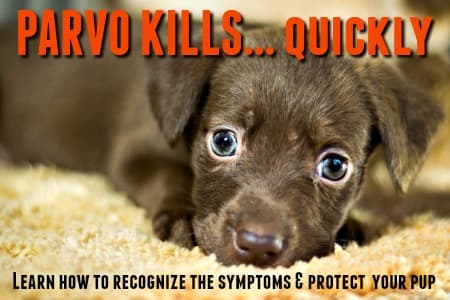FYI: If you buy something through a link on this site I may earn a commission - at NO extra cost to you.
Winter Dog Care Tips
Although our dogs wear fur all year round, they're still at risk of the discomforts, or even dangers, which come with cold winter weather.
Some breeds are better equipped than others to deal with dropping temperatures, snow and ice (think Nordic breeds and those with thick, heavy coats), but even they shouldn't spend significant amounts of time outdoors in frigid weather.
Breeds who have thin coats (this includes large dogs like Pitbulls), small or lean breeds (think Chihuahuas or Italian Greyhounds), older dogs and those who have chronic health problems are more at risk of hypothermia or other cold-weather-related issues.
This page has lots of winter dog care tips which will help you keep Fido warm, safe and happy until Spring rolls around again.
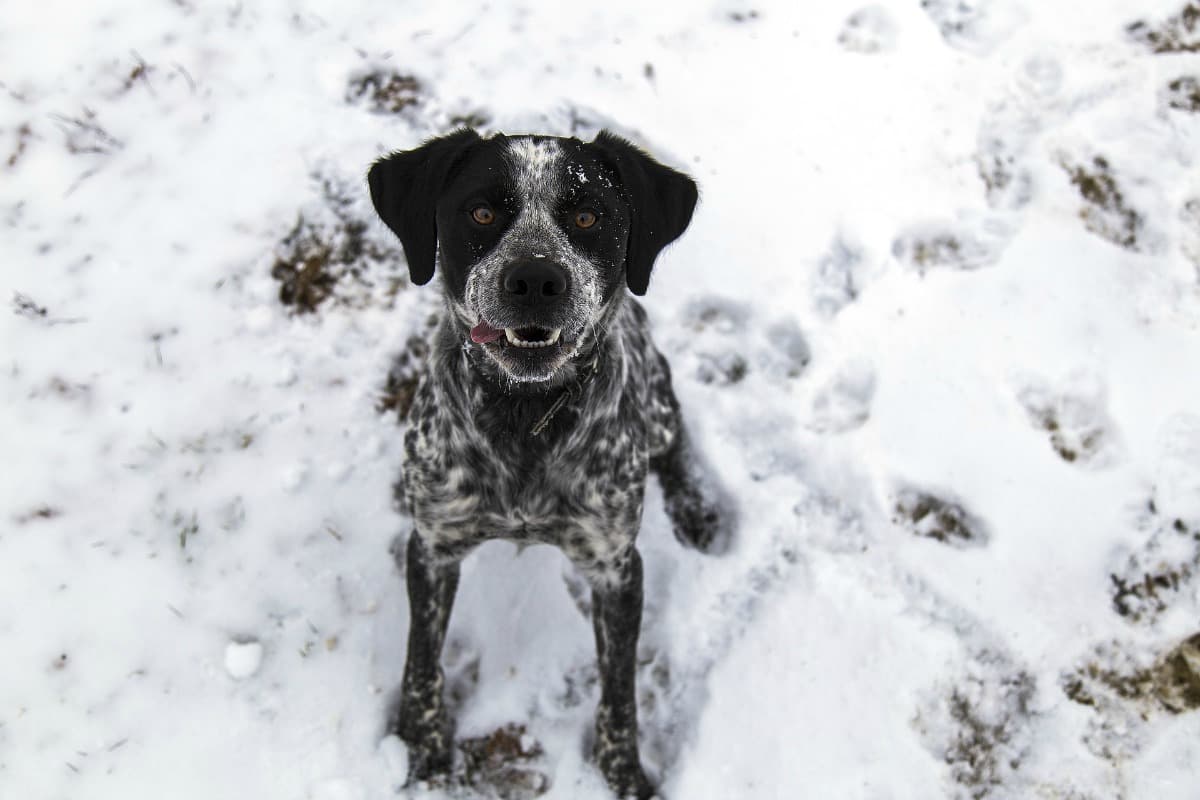
Dangers of Cold Weather for Dogs
Being cold is uncomfortable, but it can extend beyond that and become dangerous at times.
Hypothermia and frostbite are real risks for dogs who are exposed to below-freezing temperatures.
Both of these conditions can be very serious indeed, even deadly.
Other cold-weather dangers for dogs include:
- Falling through ice on lakes/rivers/ponds
- Damage to paws from commercial de-icers on the ground
- Poisoning from ingesting anti-freeze, de-icers, coolant
- Being left in cold cars
It's not only leaving dogs in hot cars that is dangerous.
A car turns into a refrigerator in cold weather and your dog can literally freeze to death inside one.
How cold is too cold for your dog?
There's no one-size fits all answer to this question because age, breed, size, coat type and/or color, and general health can all affect how a dog deals with cold temperatures.
Weather conditions other than temperature can also affect how cold a dog feels. Rain, damp, clouds and windchill can all make cooler temperatures feel colder, and allow a dog to get chilled faster.
I'd suggest starting out by just using some common sense. If it's too cold for you to be comfortable outdoors, then your dog is probably feeling the chill too.
For very tiny or thin-coated breeds, and puppies, anything below 45F may cause discomfort.
Below 32F (freezing point) most dogs other than those with very thick coats will get cold if outdoors for long, especially if they're not active and there's any rain/cloud/wind.
It's not safe for any dog to be outdoors for extended periods in below freezing temperatures.
Below 20F and there's a risk of hypothermia or frostbite for all dogs, and they should only be outdoors for potty breaks or very short exercise periods. Coats, jackets and boots are recommended for all but Nordic or heavy-coated dogs.
How to keep Fido safe in cold weather...
It's actually pretty easy to keep your dog safe from the dangers of winter weather with just a little common sense and awareness.
Keep Fido indoors
This should go without saying but sadly it doesn't. Do not keep dogs outdoors in cold weather. Instead, make sure your dog is indoors with you, other than for short potty breaks or daily walks if weather permits. If he absolutely has to be left outside for any length of time make sure he has a sturdy, insulated dog house, with the base raised off the ground, and filled with dry hay or bedding. Also, keep water bowls free of ice.
Use a collar and leash
If your dog runs off or gets out of your yard when it's snowy or icy, he'll have a harder time following the scents that will lead him back home. Plus, he is then at risk of being exposed to extreme temperatures for an extended period of time. So, don't walk your dog off-leash in winter weather or leave him unattended in your back yard. Make sure he always has up-to-date ID on his collar, and preferably a microchip as well.
Protect his paws
Your dog's paws are tough, but not so tough as not to feel the pain of cold, icy ground. Or to be burned by de-icing products or salt on the roadways. Always wash or wipe down Fido's paws after he's been outdoors - and dry them thoroughly afterwards too. Applying a little Vaseline or a product such as Pawlife Pad Rescue can put a layer of protection between Fido's feet and the cold, hard ground. They're also moisturizing, so a win-win. If your dog has a long/thick coat and there are tufts of hair between his pads, trim them down during the winter months. This helps prevent ice or snow from collecting on them while he's walking/playing, and causing him pain or discomfort. If you are taking a long walk and will be on city streets and sidewalks it's a good idea to take a small towel along so you can wipe off your dog's feet while out and about.
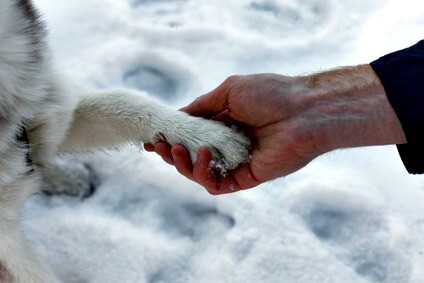
Stay away from ponds/lakes and rivers
Every year people are hurt, sometimes killed, while trying to rescue dogs from icy water. This another reason to keep Fido leashed on all winter walks. Your dog has no concept of the dangers posed by thin ice and will happily gallop onto it if he sees something of interest. If he falls through he will freeze to death quickly, and anyone who goes on the ice to attempt rescue is also in very real danger.
Keep Fido warm
If temperatures are frigid and you plan on being outdoors for more than a few minutes, most dogs will benefit from wearing a coat, jacket or sweater of some sort. Heavy-coated breeds are the exception... of course they can wear one, but they probably don't need to. Make sure whatever you choose covers Fido's belly as that is where he has little hair and will lose body heat quickly. Boots are good if your dog will tolerate them, and can walk in them. If he won't, and can't, then they can be more of a hazard than a help.
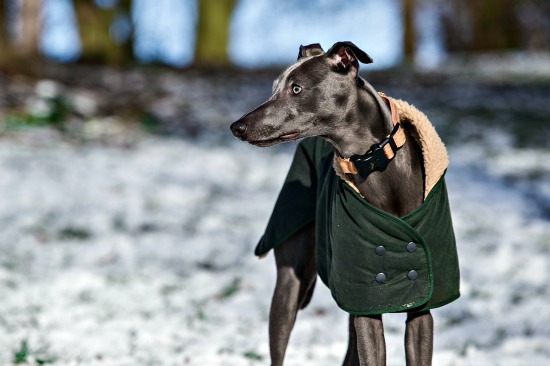
Keep Fido comfortable in cold weather
Being safe is essential, but knowing how to keep your dog comfortable when temperatures dip is important too.
Here are some simple things you can do to help Fido feel happy and comfy all winter:
Dry Fido thoroughly whenever you come indoors
When it's time to come indoors after a walk, potty break or play time, be sure to dry your dog really well. Pay special attention to his belly and paws, drying between the paw pads and removing any ice/snow which has collected. Check longer-haired breeds for ice that can attach to areas like belly, back legs and around the neck. Don't be tempted to shave or drastically trim your dog's winter coat (even long-haired breeds), it is there to keep him warm!
Add humidifiers to your home
These are good for both people and pets, especially in winter time when the air is so dry and heating systems are working full blast. Overly dry skin can become flaky and sensitive and when that happens dogs tend to itch and scratch. Which can lead to irritation and sores.
Bathe your dog less in winter
Over-bathing intensifies dry skin and combine that with winter weather and dry air and you can have problems. If Fido gets dirty or covered in ice-melt/salt etc. and you feel he really needs a bath then go ahead. You don't want that stuff on his skin. Otherwise, just drying him off is good enough.

Give him a warm place to sleep
Tile, concrete and stone floors can be very cold places in the wintertime, even with heat running continuously. Put your dog's bed on a carpeted floor, or put a thick rug between it and the cold tile. Wood is warmer than tile, but using a rug doesn't hurt there either. Keep his bed away from drafty areas and doors that lead outside. But don't be tempted to put his bed right in front of the wood-burning fireplace, radiator or other heat source as this can be dangerous. If your dog is has a thin coat, is slender or tiny, or is older or sick, a dog-safe heating pad can make all the difference. This is also great for dogs with arthritis or joint issues as it helps ease the discomfort that can increase in cold weather. Of course, it's also possible for Fido to get too warm from time to time so make sure he can get away from his 'hot spot' if he wants to (ie don't shut him in his crate with a heating pad in a 75F room).
Time your walks properly
Try not to take walks first thing in the morning or last thing at night. Those trips need to be as short as possible because temperatures are at their lowest point. If you want a trip round the block, to the dog park or whatever, choose lunchtime to mid-afternoon as this is usually the warmest part of the day. If the sun is shining so much the better. It's amazing how much heat even a winter sun can provide. Avoid walking for longer periods on cold days where the wind is high, or it's wet.
Should I feed my dog more in winter?
The answer to this is.. it depends.
Yes, a dog who is spending a fair amount of time outdoors in cold weather is going to use more calories than he would do otherwise. If he's active (ie a working dog) then this is even more true.
In this situation, yes, feeding your dog a little extra is a good way to help him stay warm and healthy through the cold months.
But, if your dog is spending 99% of his time indoors and is getting less exercise than he would in the warmer months, then increasing his calorie intake could lead to him gaining excess weight that he doesn't need.
Hypothermia in Dogs
Hypothermia happens when your dog's body temperature drops to a dangerous level. It can be mild, moderate or severe. Severe hypothermia can be fatal.
A dog's normal body temp is between 101F and 102.5F, anything below 100F is considered too low and called hypothermia.
In addition to a low body (core) temperature, hypothermia can cause a drop in heart-rate and breathing. This can affect blood flow to the brain and the rest of the body leading to organ failure, frostbite and more.
If your dog experiences hypothermia, it gives him an increased chance of developing it again in the future, so it's important to take extra precautions if you find yourself in this position.
Veterinary Care is Highly Recommended
If your dog experiences hypothermia, of any grade, the best and safest option is to get him to a veterinarian as quickly as possible.
Rewarming a hypothermic pet (or person for that matter) carries some very specific, and potentially dangerous, side effects which can only be taken care of by a veterinarian in a clinical setting.
Although in mild cases it is possible to attempt to rewarm Fido yourself, it's not something I would recommend doing.
Causes of Hypothermia in Dogs
On this page I'm focused on hypothermia caused by exposure to extremely cold conditions, being submerged in icy water, or spending extended time in cold, winter weather.
Newborn puppies and very elderly dogs are increased risk of developing hypothermia and need a higher environmental temperature than most adult dogs.
In other situations some possible causes of hypothermia can include a thyroid deficiency, circulation issues, kidney disease or a neurological problem. These are treated differently from cold-induced cases.

Symptoms of Hypothermia in Dogs
Hypothermia is a condition which generally starts out fairly mild and progresses through moderate, ending at severe if not addressed and treated early enough.
If your dog has a mild case of hypothermia his symptoms may include:
- Shivering
- Shaking
- Pale skin
- Weakness
- Lethargy
- Confusion
Symptoms of moderate hypothermia in dogs includes the above signs plus:
- Low blood pressure
- Difficulty walking
- Shallow breathing
- Pale or blue gums
Severe hypothermia in dogs can cause symptoms such as:
- Body temperature is below 95F
- Dilated pupils
- Coma
- Death
In cases of severe hypothermia caused by exposure to cold, frostbite is going to occur. It's also useful to know that a dog with a moderate to severe case will shiver initially, then stop shivering as his condition worsens.
Treating Hypothermia in Dogs
Treatment of hypothermia depends on how badly the dog has been affected and what stage he is at.
If you think your dog may be experiencing hypothermia the first, and most obvious, thing to do is to get him somewhere warm and dry.
It's important to take his temperature asap. Do this rectally.
If your dog's temperature is below 98F he is in danger and needs to be seen by your veterinarian right away.
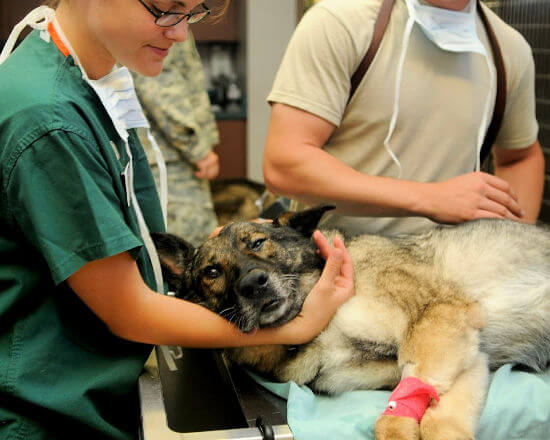
If you're not able to take his temperature, you will have to use his other symptoms to guide you. This can be risky and I'd strongly recommend having him seen by your veterinarian rather than taking any chances.
If his temp. is above 98F but below 100F you can try to warm him using these techniques at home:
- Wrap him in towels or a blaket which have been warmed in the tumble dryer. Replace and rewarm these often.
- If he's wet you can use a hair dryer set on LOW, hold it at least one foot away from him
- Rice heating pads can be warmed in the microwave, or use hot water bottles or other heating pads. Wrap these well to prevent him getting burned.
- Warm water with a little honey or sugar can help warm him from the inside out too.
If you don't see improvement within 30 minutes, or he seems to be worsening get immediate veterinary help.
It's very important to rewarm any hypothermic pet SLOWLY and carefully to prevent 'rewarming shock'.
The exact cause of this particular syndrome isn't fully understood but the circulation of both warmed, and still very cold, blood throughout the body seems to cause a severe drop in blood pressure, heart, vascular and circulation problems which can be fatal themselves.
This is just one of the reasons why getting your dog professional veterinary help if he is showing signs of hypothermia (any stage) is preferable to trying to deal with it yourself.
When is Hypothermia in dogs an emergency?
- If your dog's temperature is below 98F
- If he is listless, weak, confused
- If he's lost consciousness or is unresponsive
When a dog has moderate to severe hypothermia he needs veterinary attention right away. Treatment options might include IV fluids for warming, oxygen supplementation, warm water enemas and other re-heating methods.
He will also need to be evaluated for any internal damage (organs, neurological etc.) which might have been caused by his extremely low body temperature.
Sources used while compiling this article: ASPCA.org; AVMA.or; veterinarymedicine.dvm360.com
you might also like...
FTC Disclosure: Some pages on this site contain affiliate links. I may earn on qualified purchases.




